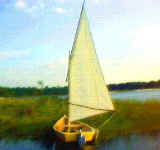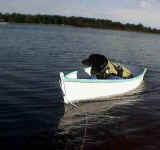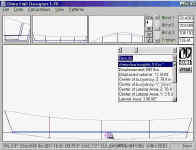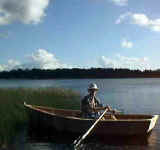Award
winning Summer Breeze! - 
This is the story of an 11'8" long 50" beam 16" sides, 500 lb capacity skiff from two sheets of 1/4" 4x8 plywood. I designed her with the help of Gregg Carlson's Hull program. For the most up to date building information look here.
 A
1/4 sized model - This is a proof of concept model.
A
1/4 sized model - This is a proof of concept model.
Full sized version build notes - More than you want to know unless you're contemplating building one. Posted chronologically. Lots of pictures.
The inspiration came from Phil Bolger and Dynamite Payson

Here's a screen shot of Gregg's Hull program showing the max load displacement.
I realized recently the distinction between displacement and capacity.
Displacement is the weight of the water she displaces (pushes aside) when
loaded, which of course includes the weight of the hull. Capacity is how much
she can hold, which is over and above the weight of the hull. Since my guess is
the finished boat will weigh about 60 lbs, I've adjusted her capacity to 500 lbs. This is really a maximum figure and I expect her rarely to be that loaded.
She's
designed as a sail and rowing skiff.
 If you only intend to row her she can be built with 2
sheets of 4x8 1/4" plywood, 1x2 stock for the gunwales and a solid or
laminated piece of 2x12 for the transom.
If you only intend to row her she can be built with 2
sheets of 4x8 1/4" plywood, 1x2 stock for the gunwales and a solid or
laminated piece of 2x12 for the transom.
The materials for the sail version is 3 sheets of 1/4" ply (one to cover the rudder leeboard and sailing bits) I originally envisioned her using one 2x12 x 16 ft spruce board to provide the transom, breast hook, quarter knees, chine logs, inwales and gunwales as well as the mast and sprit stock. I discovered that locally only pine was available in 2x12 size - spruce up to 2x6 - which is what I made the mast of. I ended up making the gunnels and odd bits out of some cypress and spruce I had, so haven't finished the layout that would be needed to get it all from one board. This is still in progress.
The Inspiration - Here's how she came to be.
My wife Julie and I took a month long boat building pilgrimage from Florida to Maine. Our adventure started at the Wooden Boat Show in Mystic Seaport and led us to boat builders, schools, and museums up the east coast.
One goal of our trip was to find out what might be the best boat to build at
our Family Boat Building camps. We really enjoyed meeting Dynamite Payson, and
Phil Bolger who partnered up back in the seventies to introduce home boat
builders to what they termed "Instant Boats." These two men have contributed
more to simplifying home boat building than anyone
else I know of. With simplicity comes greater accessibility, and the more folks
get to share the joys of gliding over the water in a craft made by their own
hands.
Anyway, when I asked these two about my kid's camp idea, they both felt the
"Teal" might be ideal project. It's a great little double ended sail
and row boat from two sheets of plywood. I bought the plans from Dynamite and
agreed to pay a royalty to Phil for every boat built if we decided to use it.
However, the closet designer in me returned to nag me.
The results was what I called during the design process my 2sheetmaximus. The
parameters were:
1. The most boat from 2 sheets of plywood.
2. Transom of 2x 12 pine to maximize the use of the ply in the hull.
3. Simple chine log and bronze nail construction using PL Premium adhesive.
4. No lofting required.
5. Simple butt block scarfing. (joining long pieces end to end)
This is primarily a sailing rowing
skiff, but it could also accept a (very) small outboard. My sailing
inclinations leads me to recommend an electric motor if you really must push her
around mechanically. A little Minnkota will do the trick nicely and let you stow
the battery amidships keeping her loaded where she most likes it.
Some may claim I cheated at the 2 sheet rule, since her sailing parts don't fit
those two sheets.. Maybe so, but Mr. Bolger did the same with Teal.
If you've got questions comments or suggestions feel free to contact me.
David Beede simplicityboats
Back to Simplicity Boats Home page.